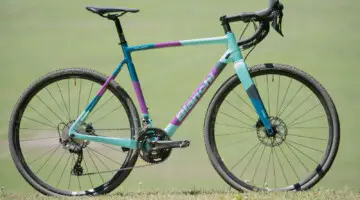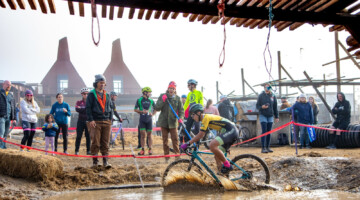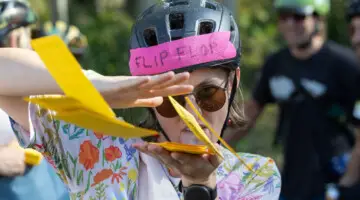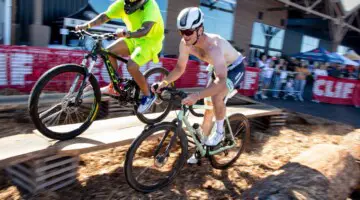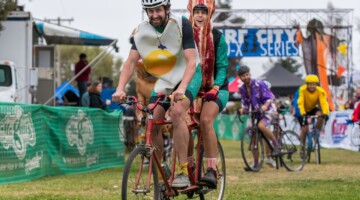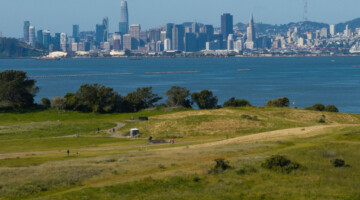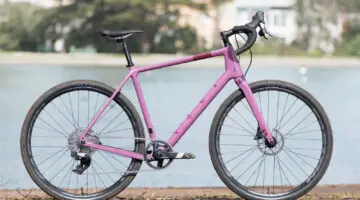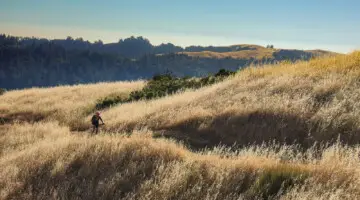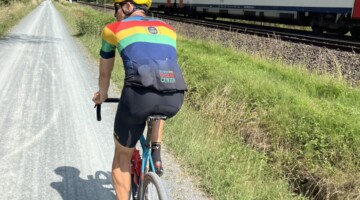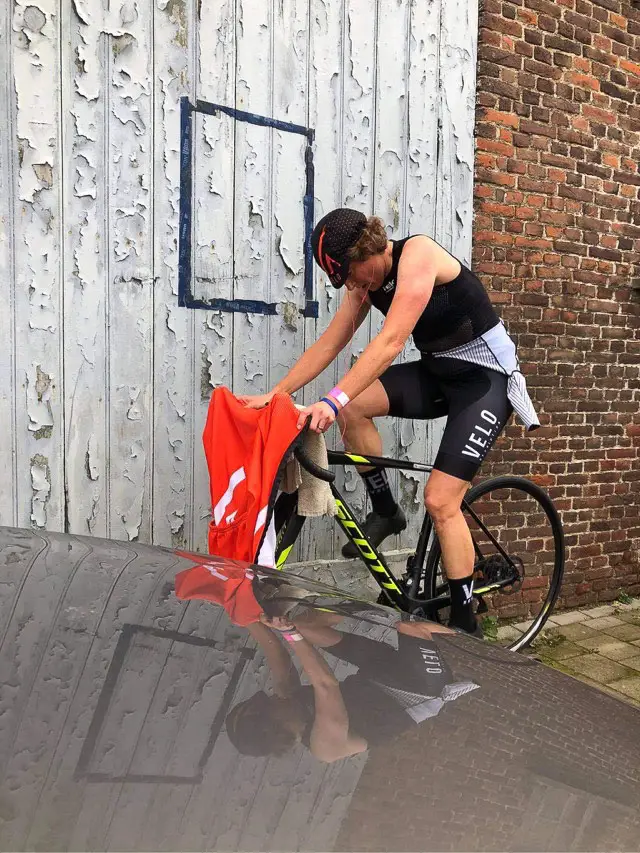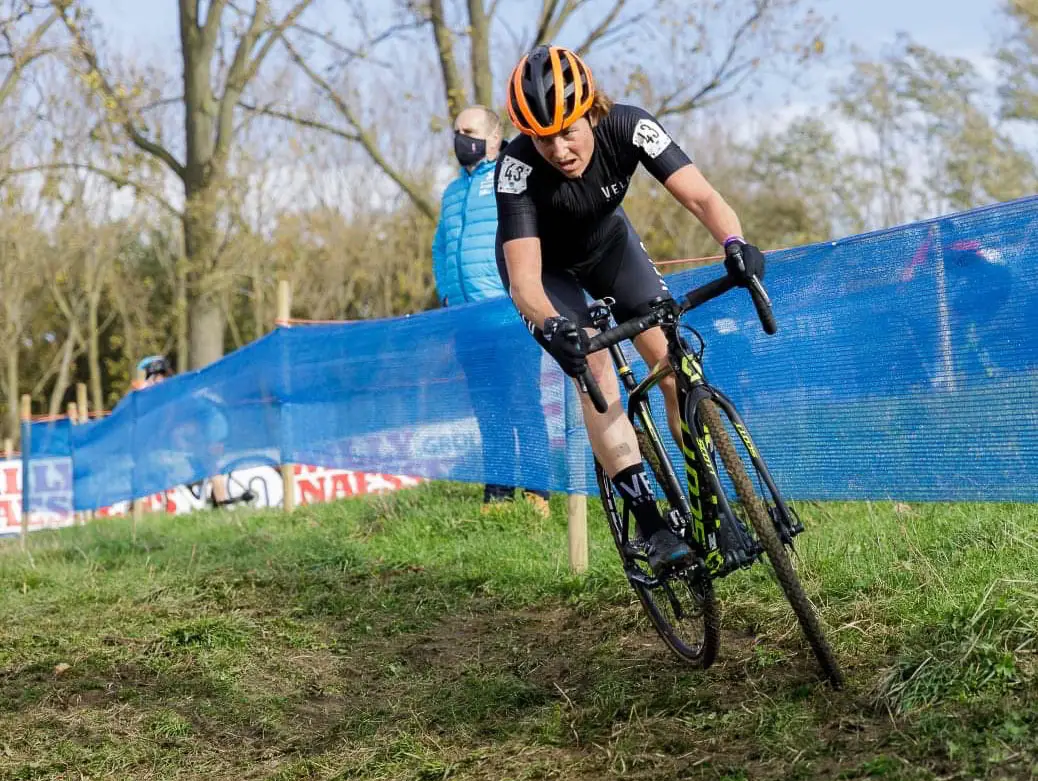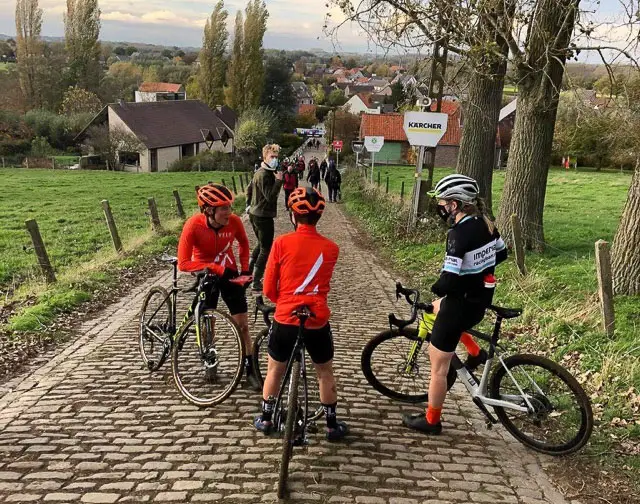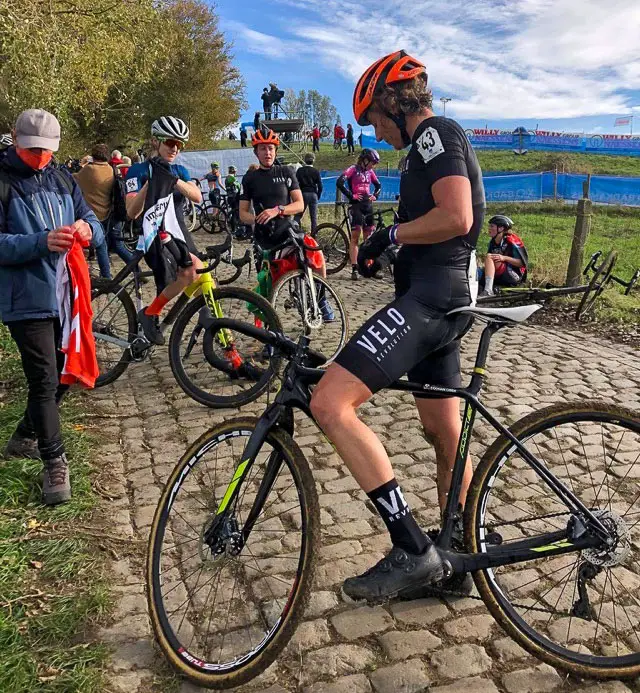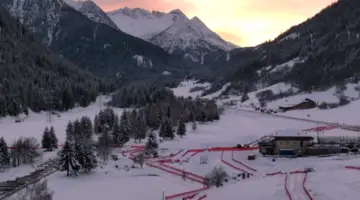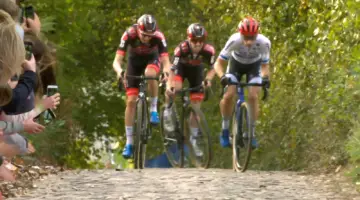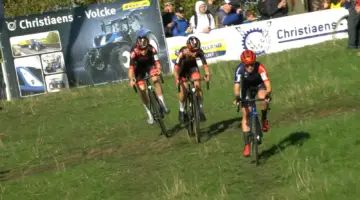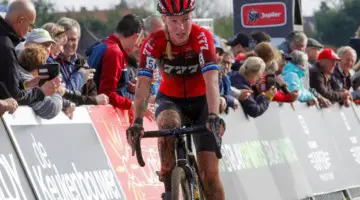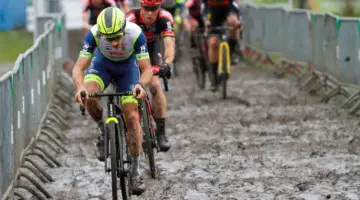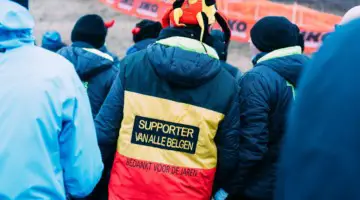Corey Coogan Cisek is back with another column that brings the life of a European cyclocross pro into your homes. She takes us behind-the-scenes at the races and in COVID-19 lockdown life in Belgium, one of Europe’s hardest-hit countries.
Enjoy the ride and stay healthy.
Life in Lockdown
Belgium is currently under a nationwide lockdown until at least December 13 to curb the spread of COVID-19 and manage hospital capacity.
Lockdown means restaurants, bars, hair salons and non-essential shops are closed. Primary and secondary schools have had their holiday break extended to November 15. Grocery stores are open, but can only sell essentials. (Yes, the Delhaize grocery has “closed” the sock section by wrapping it in plastic.)
People are allowed to visit each other outside, but in groups no larger than four and masked. Each household is also allowed one visitor, a “cuddle contact,” who can enter the home. Our Cyclocross Custom mechanic is our “cuddle contact.” While there’s no cuddling, he visits to work on bikes and drink coffee. Bike racers chose their friendships wisely!
Doubtless, people are less than thrilled to be in lockdown, but there seems to be little general angst. People’s financial well-being is assured via government support of affected industries. Remember the fear in everyone’s eyes in the spring? I’m not seeing that here.
The longer I am here, the more relaxed I become.
I watch American riders debate the moral and social implications of coming here to race. I get it. That was me four weeks ago, feeling pretty torn apart.
I don’t know about you, but the U.S.’s non-response to the virus made me into an “amateur epidemiologist.” I tracked our state’s statistics and obsessively read the emerging science. I weighed the health and moral implications of my every action. By necessity, my virus response was DIY.
It’s different here. Calmer. They have more reason to believe everything will be okay.
Let’s imagine I was a Belgian-based professional, living in a country where the virus was apolitical and the country’s response guided by science. I think I’d be less likely to second-guess the government allowing professional sport to continue.
And the good news? Lockdowns work. The number of hospitalizations peaked on November 3 and has fallen nine percent in the last week. New case numbers have also dropped among all age groups.
This time, Belgium vows to not open up fully until vaccination rates are sufficient.
Koppenbergcross
I’ll be honest, when I am racing, I hardly notice the lack of fans.
I’ve never heard much crowd noise when racing. I am very much in the zone. When I’ve noticed fans, it’s usually been a distraction: fans lumbering across an oversteekplaats (course crossing) as I am barrelling towards it, a beer cup falling at my feet…
The largest difference is the absence of fans by the campers. In past years, I’ve gotten used to fans hanging around the periphery, waiting for the right moment to ask for a rider card or photograph. Recently, I had a moment of panic: “We need to make rider cards!” But who would we give them out to?
There are true fans, who are ardent and knowledgeable about the sport. Those fans I miss.
I also miss the smell of friets. Just like the diesel from the power washers and the smell of embro, grease in damp air is the smell of cross.
Yet, can I tell you how much easier it is to get to the start? I’m used to allowing ten minutes to patiently (or impatiently) weave my way through throngs of fans who walk aimlessly (often drunkenly) down the main thoroughfares. Now, zoom, it takes just a couple of minutes to get from the campers to the start line.
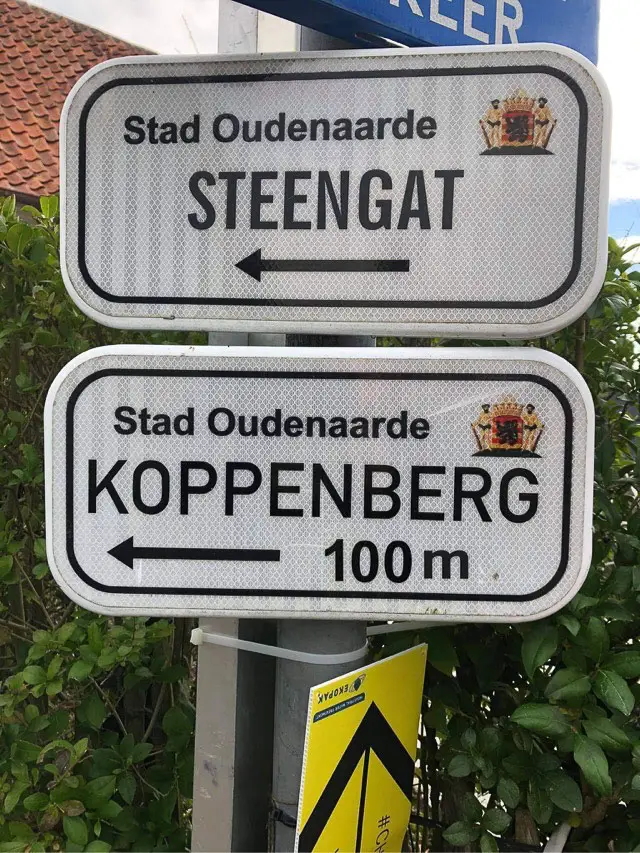
Without fans lining the course, you can see the signs and navigate the venue easily. photo: courtesy
Can a race be iconic without fans?
The Koppenberg was. You can take away the fans, but you cannot take away the cobbles or the cow manure. The Koppenberg is unforgettable for its suffering, bleeding from the eyeballs sort of pain.
So much of bike racing generally comes down to trying to hang with a pack. You lose the wheel and you’ve lost. The Koppenberg is much more “you versus the course.” The cobbled climb gets all the attention, but it’s the grassy climbs that are likely to crack you. If you go too deep into the well, you will be walking.
I had a good day at Koppenbergcross. I would have termed it “excellent,” were it not for a silly fall, costing time and positions. It was a confidence builder. While I was doubting my form due to lack of racing, the Koppenberg confirmed my fitness. You cannot “fake it” on the Koppenberg. You have the fitness or you don’t.
A couple of days post-Koppenberg, I was wondering what accounted for an “off” smell in my room. Pro tip: even if your shoes aren’t really muddy post-Koppenberg, it’s still a good idea to wash them. 360 or so days a year, it’s a cow field.
Preriding Niel Jaarmaartcross
Michelle and I have been pre-ride buddies since the middle of last season. Yet, it’s something we are still working on. Our pre-rides are hit or miss.
We usually pre-ride on Wednesdays or three days before the race.
When I say pre-ride, you probably think of the North American version, the promoter-assigned time when the course is open for review. That’s not how it works in Belgium.
On Wednesday, the course is generally 60 to 75% built. The grass sections are typically fully fenced, but oftentimes bridges are partially or not at all built. If the course covers city streets, the streets naturally remain open to traffic. There are workers still building as you pre-ride.
In the U.S., if you tried to ride while work was ongoing, you’d be thrown off in no uncertain terms! In Belgium, the volunteers often pause to watch, critique, cheer or ask what you think of the course.
Unfortunately, midweek pre-rides run the gamut for us. They can be super impactful and prepare us for the weekend or they can be tiresome, a near waste of time. Sometimes, we can effectively session and do hot laps. Other times, we devote lots of time just orienting ourselves.
Step one of pre-ride is the navigational challenge. How do you locate the venue and a parking place without the race day signage?
We typically use the map of the parcours on the website, setting a pin at a nearby business.
Then we find a place to park, seeking a balance between close to the course and an absence of no parking signs. At least half the time, someone tells us to move…often in no uncertain terms.
Then there’s locating the course direction. Literally, do you turn left or right when you intersect the course? Usually, this is not a problem, as there are the before-mentioned workers or other riders.
We pre-rode Niel on a Sunday since the race is on Wednesday, Armistice Day. There was an absence of workers because it was Sunday. There was an absence of riders because it was the second day of the European Champs.
Would it surprise you if I said there were guardrails intersecting the course?
We climbed straight up a hill and met a guardrail. Next to us, it was evident that the course came down through a guard rail.
In the U.S., if you wanted to run a race onto a city street, you might be able to get a permit for it. It seems unlikely that the city would temporarily remove the guardrails for your race.
Yet, in Niel, if you want your race to go from a park to the city streets and back, they’ll remove the guardrails.
Fortunately, Michelle and I found a junior boy who gave us a course tour. He saved us countless minutes of staring at our phones trying to match the parcours map.
Belgium is all about insider knowledge. Next time, we will know where to park. Next time, we will know where the course goes. Next time, we will know that doing efforts/hot laps at Niel is nearly impossible…per countless city streets and not-yet-built bridges.
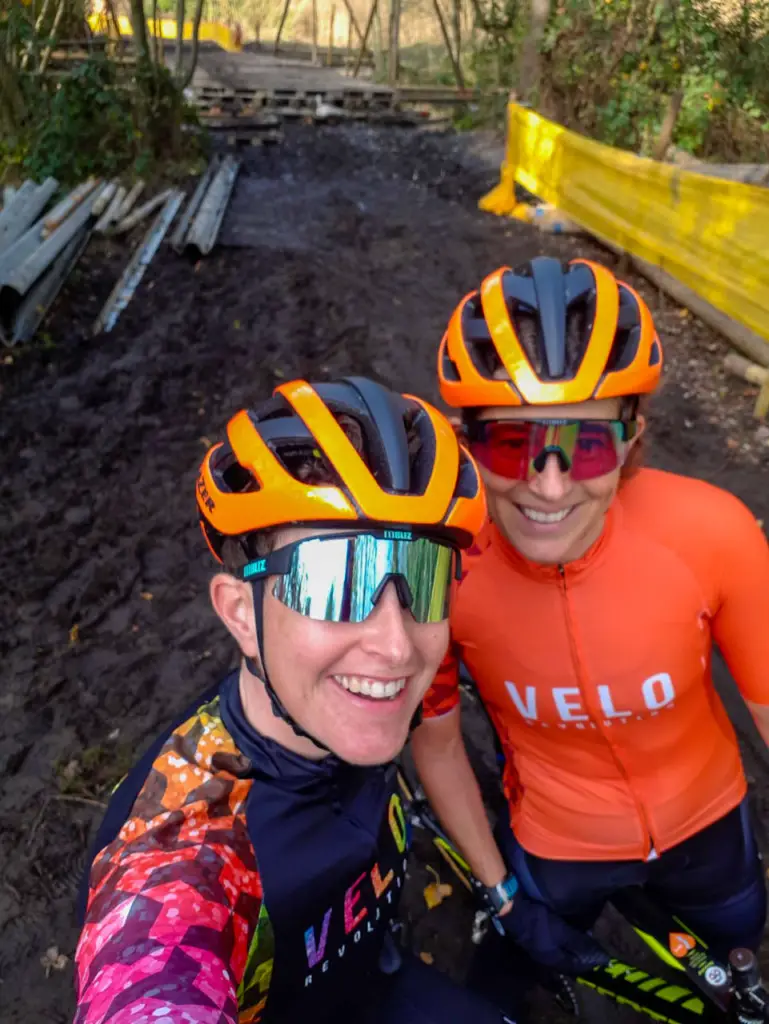
Corey Coogan Cisek and teammate Michelle Geoghegan pre-riding Niel, before the course bridge is complete. photo: courtesy
[Corey Coogan Cisek finished 46th in Niel. See the full results here.]
Next Up:
After Niel, we will be on a one-race-a-weekend pattern for a while. Leuven is Saturday, November 14. Merksplas is Saturday, November 21.

